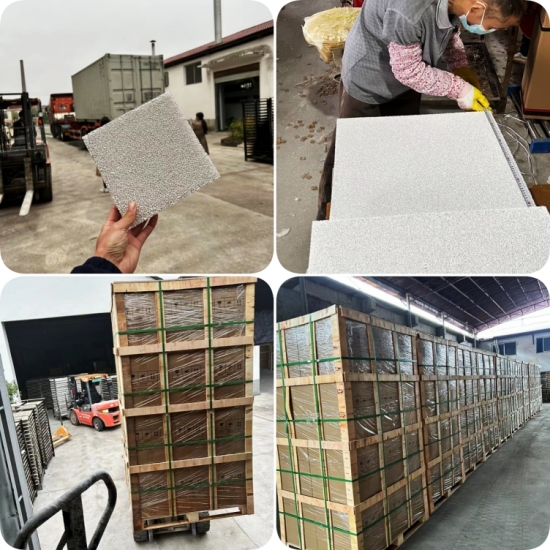Feb. 14, 2023
Alumina Ceramic Foam Filter Plates are produced by the organic foam sponge with three-dimensional network structure and connected pores is used as the carrier, which is infiltrated into the special ceramic slurry with thixotropy, and a special rolling process is adopted to make the ceramic slurry evenly spread on the skeleton of the carrier, and then finished by roasting at high temperature after drying curing.

Main points:
● Commonly used in the production of aluminum and aluminum alloys 178×178×50mm, 230×230×50mm, 305×305×50mm, 381×381×50mm, 432×432×50mm, 508×508×50mm, 584×584×50mm.
● The model of the product is represented by the customary appellation P. The number in front of the English letter P represents the pore density of the product and corresponds to the pore uniformity. For example, model 10P means a foam ceramic filter product with a pore uniformity of 7-13 pores on any 25.4mm length.
● Light transmittance refers to the effective filtering area of the foam ceramic filter plate product. The higher the transmittance, the fewer blind holes, the more effective filter holes (display holes), and the better the filtering effect.
● Porosity refers to the percentage of the total volume of pores in the filter plate product to the total volume of the filter plate product. The porosity determines the filtration capacity of the foam ceramic filter plate per unit volume. The larger the porosity, the greater the filtration flow of the filter plate and the stronger the filtration capacity, and vice versa.
● Pore uniformity is used to describe the difference between the actual number of pores per 25.4mm length in the filter plate product and the theoretically required number of pores. The smaller the gap, the better the product quality. If the gap is too large, the filter plate product will reduce the retention capacity of impurities or the filtration speed of the melt is too slow, which cannot meet the individual requirements of users in production. The size of the pore uniformity mainly depends on the foam used in the production of the filter plate. The pore uniformity of the foam is good, and the pore uniformity of the filter plate is good, so the selection of the foam is extremely important.
| Item | Allowable variation | |||
| ≤381mm | 381mm~430mm | ≥430mm | ||
| Side length allowable variation(mm) | ±3 | ±4 | ±5 | |
| Diagonal line allowable variation(mm) | ±5 | ±7 | ±9 | |
| Plane clearance allowable variation(mm) | ≤3 | ≤6 | ||
| Thickness allowable variation(mm) | ±2 | |||
| Side rake allowable variation(°) | ±1° | |||
Remarks: 1. Diagonal deviation refers to the difference between the lengths of two diagonals on large surface of filter plate. 2. The plane gap is to place the large surface of filter plate on platform, and measure the gap between filter plate and platform. 3. Side bevel refers to the angle between side bevel and large surface. 4. The filter plates involved in the table are all products with a theoretical thickness of 50mm and a side inclination angle of 17.5°. | ||||
Fiberglass Cap Filter For Car Wheel Hub And Pistons
Apr. 14, 2025
Contact Us
+86 158 3011 4065
Guoruiyuan Building, ShengLi North Street, Chang'An District, Shijiazhuang City, Hebei Province, China.
Navigation
Navigation




